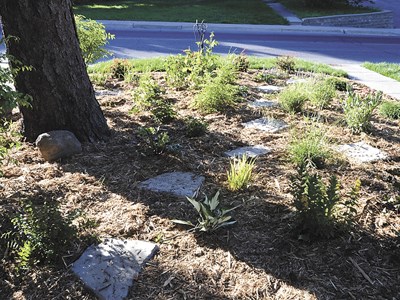I’m a mulcher. Like my grandmother and mother before me, mulching runs deep in my veins. These ladies taught me a thing or two about the thriftiness of mulching well.
Back in the day, I can imagine there being only a few types of mulch available: cardboard, newspaper, straw and leaves. Today, you can be faced with a dizzying, not to mention expensive, variety. Let’s look at the benefits of each:
Newspaper
While this choice has nothing going for it aesthetically, it really is the number one weed blocker, short of plastic sheets. Many gardeners I know use a layer of wet newspaper to keep the weeds away. Like, for good.
There isn’t a weed strong enough to penetrate the thickness of a wet newspaper. In five years, it’ll have broken down so you don’t have to be pulling it out to refresh it. And it’s free.
But keep in mind that newspaper is high in carbon, so its disintegration will create higher levels of nitrogen, which can turn some younger plants yellow. If this is the case, fertilize as necessary.
If the thought of newspaper spread across your yard makes you cringe, you can always cover it with the mulch of your choice.
Cedar and pine
Pine or cedar mulch is made from grinding up waste wood, like pallets, Christmas trees and other waste wood products. Using these, you’re doing an environmental service, since this waste would otherwise end up in the landfill.
And who doesn’t love forking fresh cedar mulch onto the garden bed? What a smell! This variety, known as “decorative mulch,” comes in a variety of colours, from rust to brown to black. While most of these varieties now boast using “natural dyes,” which are harmless, they can stain clothing and skin.
If you have a lot of ground to cover, you might consider getting a truckload delivered. I like to work with a lot of mulch, ensuring that there is at least three inches above the soil.
A thick layer of rotting cedar or pine can attract mold or insect pests. To prevent this from happening, it’s best to avoid walking directly on top of it.
A stone pathway will encourage others to stay off as well. You can also “fluff” it up occasionally to encourage airflow. And remember to keep this mulch away from the base of any plants, since its breaking down causes it to heat up, which can cause the plant to rot.
Straw
Straw is most commonly found in vegetable gardens and is preferred here over cedar mulch, since cedar does have a low level of toxicity that could perhaps transfer to the plants you’re growing.
I find that the newspaper and straw combination does the best at restricting weed growth. Straw can be expensive, but acts as a great insulator.
It breaks down easily after a season and can be turned into the soil to supply it with organic matter. You can easily find bales in the fall at the greenhouses, but short of that, look in the classifieds or visit a local farm.
Anne Boulton is an avid gardener who lives in Sudbury. Visit her blog at greenboots.ca or contact her at [email protected].
Posted by Vivian Scinto
Join Sudbury.com+
- Messages
- Post a Listing
- Your Listings
- Your Profile
- Your Subscriptions
- Your Likes
- Your Business
- Support Local News
- Payment History
Sudbury.com+ members
Already a +member?
Not a +member?
Sign up for a Sudbury.com+ account for instant access to upcoming contests, local offers, auctions and so much more.
